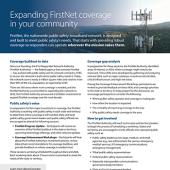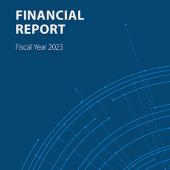This blog is a repost from APCO’s PSC Magazine, originally published in November 2023.
The Super Bowl. A Category 5 hurricane. A global pandemic. What do these all have in common? They have a major effect on communities — but happen rarely. In the world of public safety, first responders must be ready to act swiftly when high-priority, low-frequency events like these occur.
Effective response — whether in daily operations or during these critical events — begins with reliable communications and information sharing. First responders are integrating data-based tech solutions into their operations, so they are prepared for any emergency. Today, many of these solutions are powered by FirstNet, the nationwide broadband network dedicated to public safety.
FirstNet was built to be interoperable, secure, and reliable. It supports mission-critical services that are helping responders contend with a wide range of emergencies, incidents, and events. The 9-1-1 community is taking notice, integrating FirstNet to aid in high-priority, low-frequency events through unique capabilities, such as remote call taking and dispatch, tactical dispatch in the field, and redundancy.
Remote 9-1-1 put into practice during the pandemic
When it comes to emergency communications, Renee Gordon has seen it all. A former police officer, she now serves as director of the Department of Emergency and Customer Communications Center in Alexandria, Virginia. Most recently, she took on the role of vice chair of the FirstNet Authority Board where she helps guide important issues related to FirstNet and brings 9-1-1 community voices to the forefront.
In 2020, Gordon and her team faced one of their most serious challenges — how to keep their staff safe during the pandemic. Like many other public safety leaders, she needed a way to provide social distancing and quarantining for staff in a job that — at the time — demanded they work in person, in close quarters.
Alexandria 9-1-1 dispatchers and call takers started using FirstNet-powered hotspots and devices to work from home, taking calls and managing computer-aided dispatch(CAD) operations remotely. “We didn’t want to rely on people’s home internet because we know they can lose connectivity,” explained Gordon. “We knew we wouldn’t lose connectivity with FirstNet.”
This was one of the first times in the country that remote 9-1-1 call taking was possible. It was critical to ensure public safety telecommunicators could continue serving their community while also staying safe themselves. It was first implemented as a test during the pandemic, but the City of Alexandria has now adopted remote work practices on a permanent basis.
Unexpected events can double up on each other, making the flexibility of remote work especially useful. Staff can quickly set up where they are, ready to support operations. Still in the midst of the pandemic, during an unexpected period of high calls in the area, Arlington, Virginia, administrators found that they were able to immediately activate additional telecommunicators at their homes, rather than wait for them to travel up to two hours into the city.
The pandemic launched innovations that are redefining the future of dispatch operations. It also opened the door to a new way to respond during high-priority, low-frequency events. Through remote 9-1-1, emergency communications centers (ECCs) can explore ways to staff up with the help of remote telecommunicators during natural disasters and other major events that can overtax an ECC team.
Tactical dispatch during critical events
Tactical dispatch and telecommunicator emergency response taskforces (TERTs) offer another creative solution for emergency communications during critical events.
When activated, a TERT mobilizes telecommunicators to aid in situations where additional emergency resources are needed. This often occurs during high-priority, low-frequency events, such as a major planned event, an active shooter incident or following severe weather. TERTs can be deployed on site to assist or staff up through remote response, and they may consist of telecommunicators from the requesting agency or from outside agencies. Portable routers and device hotspots allow telecommunicators to access the CAD and 9-1-1 workstations from anywhere, so they can begin taking calls almost immediately.
In Ohio, Hamilton County Communications Center (HCCC) has developed a tactical backup system comprised of 15 workstations that can be deployed anywhere there is electric and data capability. In addition, select members of the team have equipment at their residence that allows them to assist in call taking without delay or travel time.
This system was put to the test during a major storm that resulted in nearly a thousand emergency calls within a four-hour timespan. HCCC Director Andrew Knapp set up a hotspot on his phone and used a remote 9-1-1 setup to respond to calls and coordinate with first responders. "Emergency communications centers have found that their service is not limited to the boundary of their own walls," Knapp said.
FirstNet as a backup for 9-1-1 systems
FirstNet also provides redundancy and resiliency for 9-1-1 systems, helping ECCs guard against sudden and unexpected network disruptions and outages. FirstNet’s reliable connection, interoperability and robust security make it ideal for built-in redundancy.
The Tennessee Emergency Communications Board (TECB) considered all of these factors when selecting a new backup system for the state’s 9-1-1 systems. After significant evaluation and testing, TECB chose FirstNet as its wireless backup connection. TECB is now integrating FirstNet into all 134 ECCs statewide.
Curtis Sutton, executive director of the TECB, said testing the backup connection showed that the transition to FirstNet was seamless. "You could hardly tell that the fiber connections went down and FirstNet picked up."
The TECB found that FirstNet proved useful in real-world scenarios too. While transitioning to a fiber connection, local dispatchers relied on FirstNet during the transition to take live calls without missing a beat.
Many ECCs are now integrating FirstNet as a wireless backup for those critical moments when their primary network fails or is offline for maintenance. FirstNet helps these agencies stay agile and responsive in any emergency.
Innovating for the future of 9-1-1
Public safety telecommunicators are the first, first responders. They’re the first to take the call in those critical moments. During high-priority, low-frequency events, communication is vital to their success and ability to help. FirstNet is providing the technology they need to be prepared for any incident.
“FirstNet is a tool that we need to do our jobs in public safety,” explained Gordon. “Let's use the tools that we've been given.”




















